Barrier-Free: Beginning of the Performing Arts Accessible to All
Sang Mi Shin_General manager of Arts Support Department at Korea Disability
Arts & Culture Center
Compared to the previous years, barrier-free performances are increasingly gaining diversity. A “barrier-free performance” refers to a performance focused on everyone’s access to performing arts content. This is to ensure enjoyment without any discrimination. Such an approach has been actively attempted, mostly in the theater and dance. Examples of this include audio description1) and touch tours2) for persons with visual impairment, sign language interpreting and written translation (subtitles) Written translation (subtitles)3) for persons with visual impairment, and relaxed performances4) for persons with development disabilities and autism. Moreover, creators (actors, writers and staff) with disabilities participate in the production of performances from the phase of creation and finally present their performances. In this way, the barrier-free approach is adopted in a wide variety of settings including creation and enjoyment, which is quite encouraging.
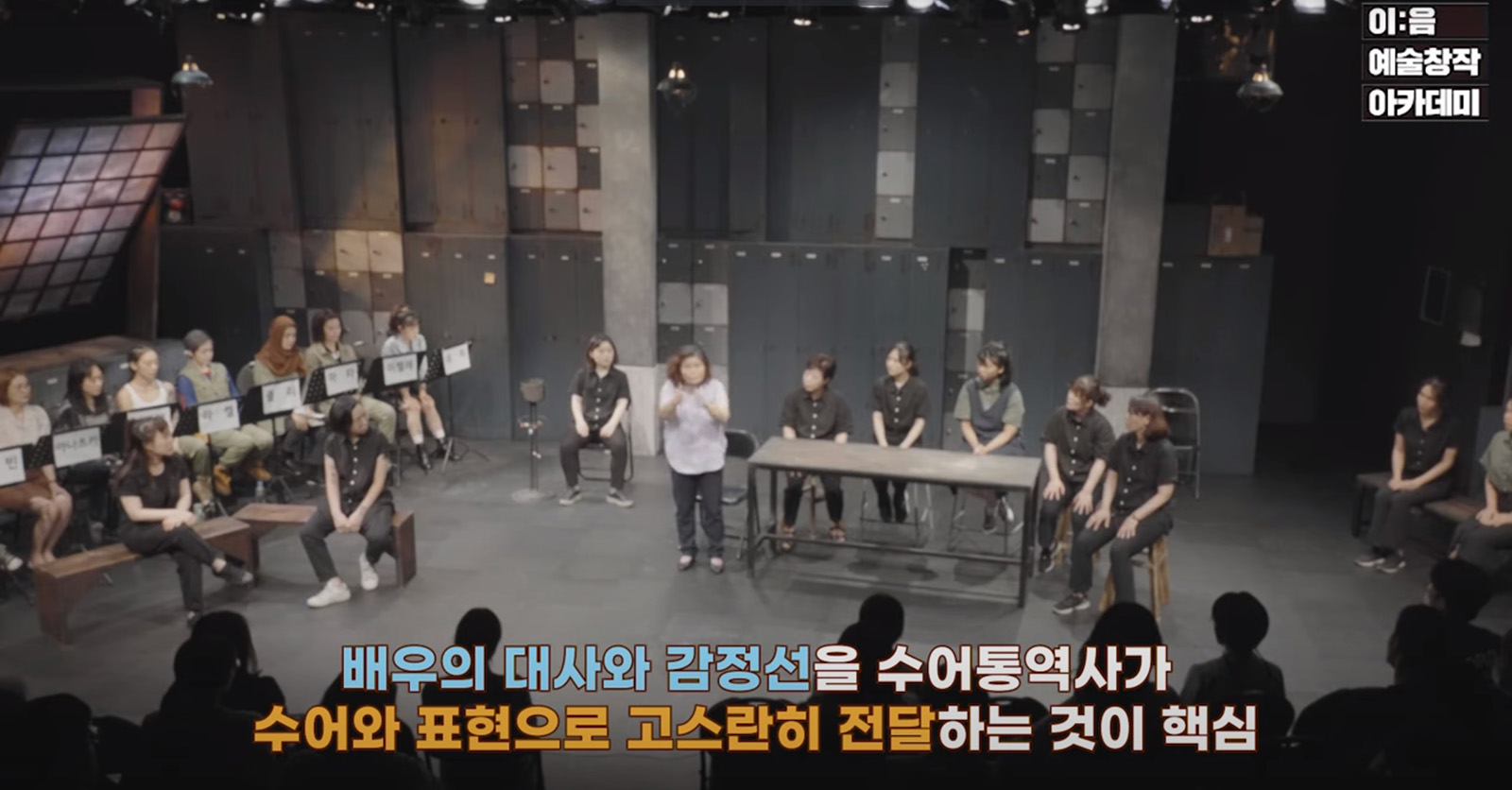
〈Sette Minuti〉: Video of making the performance (source: Korea Disability Arts & Culture Center Youtube)
Korea’s Barrier-Free Performances Starting from Enjoyment and Heading to Creation
Barrier-free productions began with arts companies of persons with disabilities.5) But it seems that the approach came to be actively discussed with the participation of the public sector. Starting with the play〈Route 7〉in its 2019 season, Namsan Arts Center provided sign language interpreting and written translation for persons with hearing impairment and audio description for persons with visual impairment. The center also offer these services in three other performances:〈On Pluto〉,〈Inflexibility〉and〈End of the Month, or the Way You Remember the World〉. In 2020, the theater presented all shows of its seasonal performance〈Great Revival of Namsan Arts Center〉in a barrier-free way while also producing a leaflet in braille and a promotional video of the performance in sign language.
Also in 2020, the Arts Council Korea (Arko) provided sign language interpreting, written translation and audio description during the live broadcast of the creative mask dance〈Othello and Iago〉by the Greatest Masque. In 2021, Arko Arts Theater supported production of a barrier-free version for some of the performances selected for theater space rental, thus presenting five performances6)
Korea Disability Arts & Culture Center has also made diverse attempts regarding the barrier-free approach. In 2019, performances that were invited to the international showcase of Ieum provided subtitles and sign language interpreting. In 2020, the Center produced the online live performance〈Break: Destruction, Halt, Break and Transition〉. In this performance, there is a scene where Lee DongWoo, an actor with visual impairment, and Lee SoByeol, an actress with hearing impairment, meet each other. The center thought about how to communicate and tell the story from this scene in a barrier-free way. Consequently, it added audio description and sign language interpreting to the entire performance. This year, as a preview of the 2021 Disability-Free Arts Week,〈One〉and〈Once upon a Time〉by Goblin Party were produced as a dance film. Dancers in wheelchairs participated in the production process to reconstitute and re-create the existing choreography. And Lee KyungGu, choreographer and dancer of the performances, wrote and read the audio description.
The School of Drama at Korea National University of Arts presented the online performance〈A Village〉which was made as part of a Korea-Japan co-production project. All the shows of the performance offered sign language interpreting, subtitles and audio description. What is notable is the fact that the staff of the performance had a “barrier-free manager” and “barrier-free monitoring team.” Korea is just at the beginning of considering accessibility and barrier-free performances. So it has almost no institution or organization specializing in accessibility.7) Despite this, the performance〈A Village〉had a barrier-free manager who had worked with artists with disabilities, in order to improve its accessibility. The barrier-free manager’s role was to review the performance’s physical and psychological accessibility based on a good understanding of the creator’s intention, to find any problem or “barrier,” and to cooperate in the production process without missing even the smallest things.8) This was impressive. The National Theater Company of Korea collaborated with Korea Disability Arts & Culture Center to produce an online barrier-free version of the repertory performance〈Scapin〉, thus taking the first step for the audience with disabilities. The company produced different versions of the performance: original performance, the one with audio description and the one with sign language interpreting and written translation. This was to serve those with different needs. In 2021, the company is preparing〈Creative Empathy: Directing〉under the theme of the arts by persons with disabilities.
〈Ten Million Cities〉, which was recently presented by Seoul Theatre Company, is a barrier-free performance characterized by its diversity; its cast includes foreigners and persons with disabilities. Preparing the performance, the company installed a wheelchair ramp and changed the threshold of its rehearsal room for performers in wheelchairs. They also had sign language interpreters throughout the rehearsal period for performers with hearing impairment. During the performance, the company provided sign language interpreting, written translation and audio description. Depending on the different scenes and roles, it also attempted shadow interpreting. In short, the performance〈Ten Million Cities〉considered the physical accessibility of not only the audience with disabilities but also the participating artists with disabilities. It would have been an occasion to allow all its staff members to become aware of the barrier-free approach.
The play〈Sette Minuti〉by troupe Watchman has eleven actors and eleven sign language interpreters for the audience with hearing impairment. In this way, the troupe tested this new way in which an actor and sign language interpreter play the same role together. Considering the structure of the stage, the performers were sitting at the back to read their text, which was regrettable. Nevertheless, the performance’s new format was interesting. In many cases, a couple of sign language interpreters play multiple roles. But in this performance, a sign language interpreter was assigned to each role. So the interpreters were on stage to speak their lines and to discuss with other characters. This was an interesting approach.
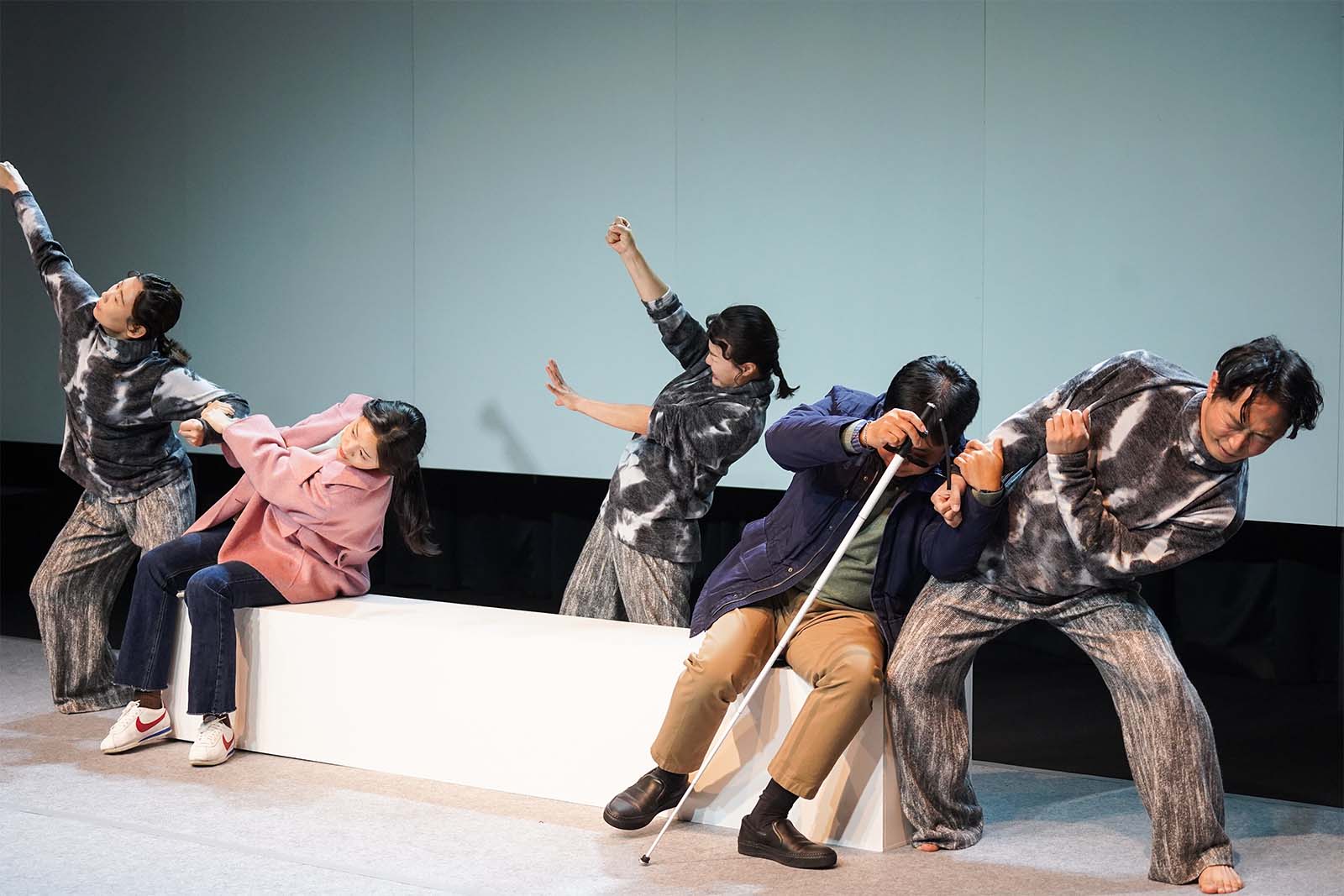 |
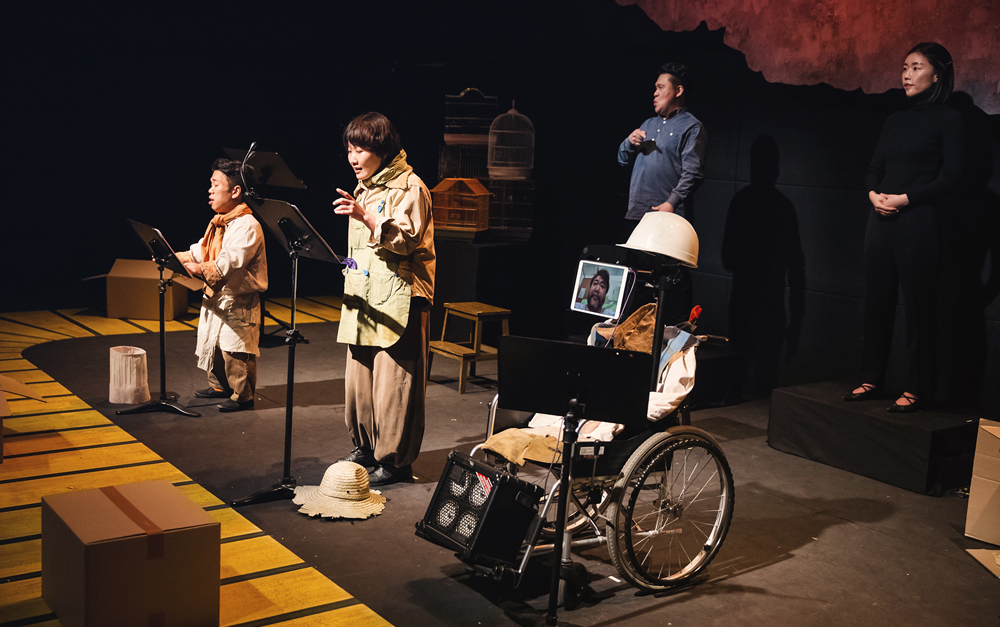 |
| BREAK: Destruction, Halt, Break and Transition (source: Korea Disability Arts & Culture Center) |
A Village @Kim Sol (source: Korea National University of Arts) |
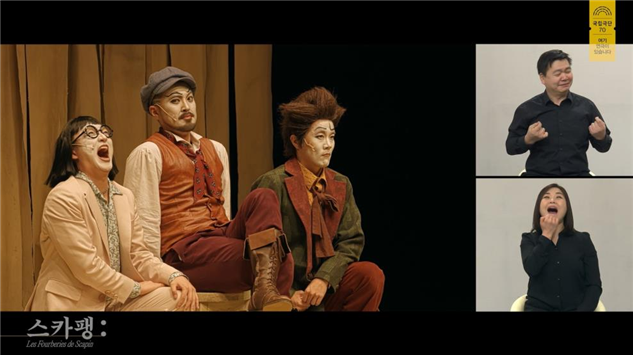 |
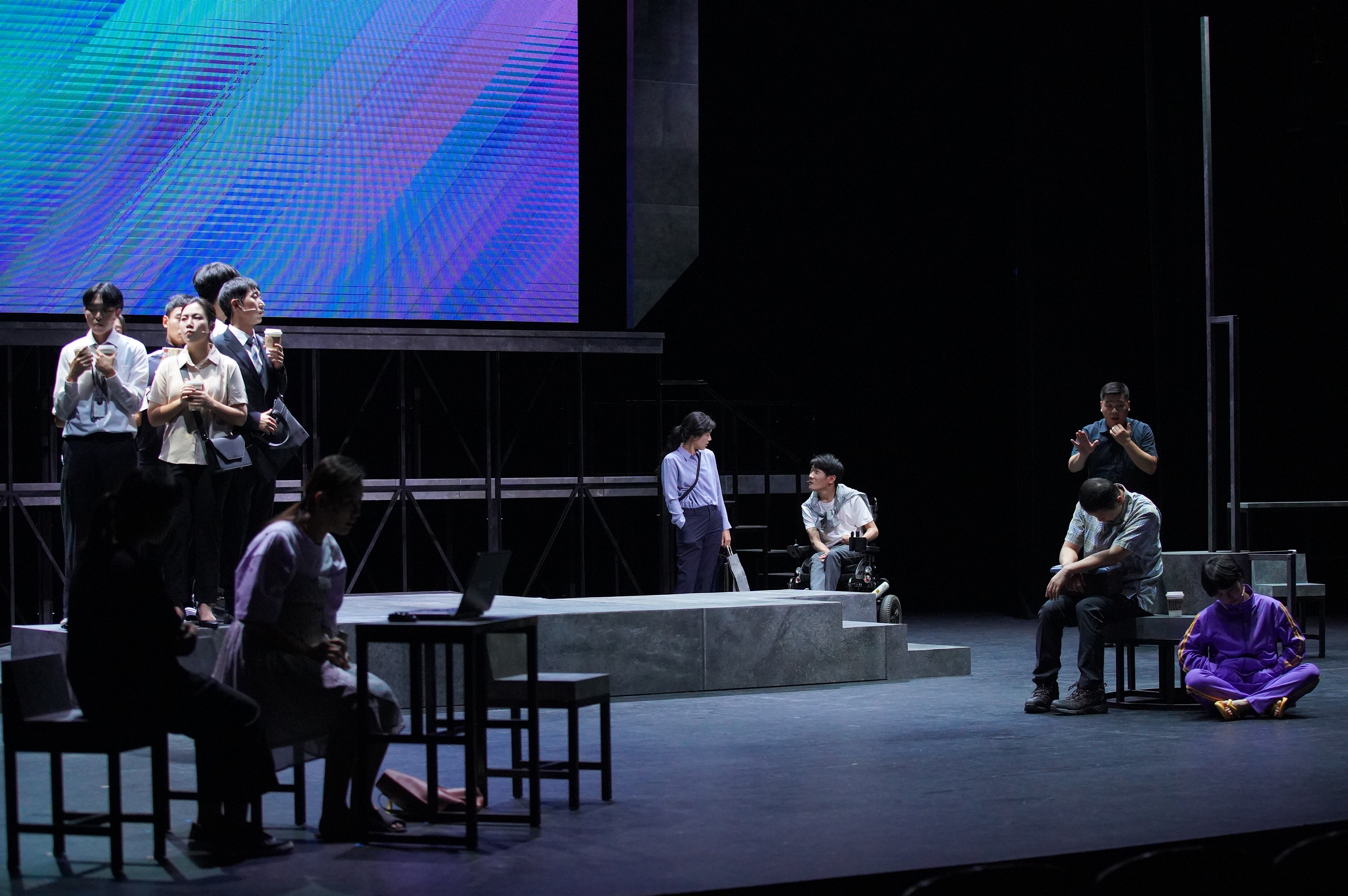 |
| Scapin (source: National Theater Company of Korea) | Ten Million Cities (source: Seoul Metropolitan Theatre) |
International Barrier-Free Performances Encompassing Creation, Performances and Information
Scotland’s first theatre company to recruit performers regardless of their disabilities was Birds of Paradise. Since its founding in 1993 as a charity, the company has cooperated with different organizations in and out of Scotland to produce and stage new performances. What is particularly impressive among the company’s works is〈MY LEFT/RIGHT FOOT〉, a musical produced in collaboration with the National Theatre of Scotland. The musical had Natalie Macdonald, sign language interpreter and actress, and all its shows offered sign language interpreting and written translation. Some of the shows also provided a relaxed performance. In order to share information on the performance, the company produced a trailer in sign language, audio leaflet, audio description of the characters and stage set, visual guide and map of the theatre. In this way, the company makes sure that the audience with disabilities get information on performances, buy tickets and enjoy themselves in the theatre, without any inconvenience.
Britain’s Graeae Theatre Company, which was founded in 1980, presents popular works of different genres including outdoor performances, plays and operas. The company is led by persons with disabilities. The company provides audio description for persons with visual impairment and British sign language interpreting and subtitles for persons with hearing impairment, from the phase of production. The company focuses on improving the professionalism of actors with hearing impairment. For both Graeae and Birds of Paradise, sign language interpreters exist on stage as performers playing the roles of characters, not as interpreters. Producing works in this way, the companies naturally combine stories with sign language interpreting. As they present performances, they actively support the seamless communication between artists with different disabilities and those without disabilities.
In addition to these two companies, many international arts companies (of persons with disabilities), festivals and organizations make great effort to embrace different groups of audience including persons with disabilities, foreigners, those who are culturally marginalized and children. In particular, they share the schedule of barrier-free performances through online platforms that offer audio description and sign language interpreting so that people could purchase tickets in advance. They also try to help the audience get information through diagrams indicating performance services for persons with disabilities.9) Furthermore, major national and public theaters, companies and festivals regard accessibility services as essential.10) This is something Korea needs to take note of.
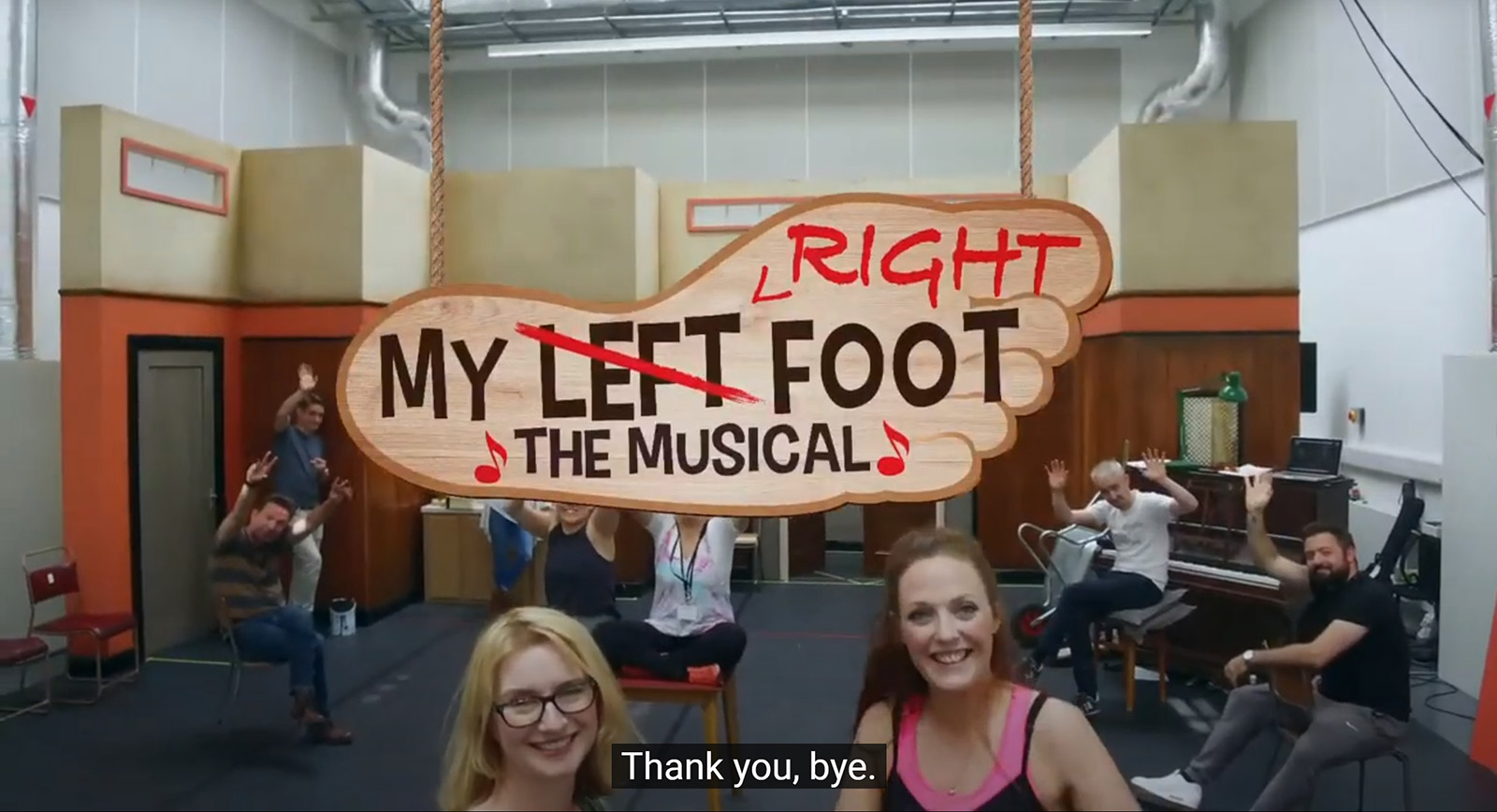
〈MY LEFT RIGHT FOOT〉(BSL trailer) (source: YouTube channel of Birds of Paradise)
It Is Time to Reflect on the Universality and Specificity of Barrier-Free Performances Together
In the Korean performing arts scene, production of barrier-free performances is still at its early stage. So not many Korean performances have been produced as barrier-free ones from the phase of creation, for playwriting, stage sets, directing and casting. In most cases, a performance is produced and a barrier-free version is added to it. And even such barrier-free versions are not numerous. Most importantly, production of a barrier-free version of a performance requires a communication process to ensure cooperation and understanding between the creator and barrier-free professionals (organization). It also takes an additional budget and production period, which are quite big. And there are many other challenges including the copyright issue. So it is burdensome for individual artists and companies to produce a barrier-free performance. From the perspective of sustainability, it is not easy to produce barrier-free performances without public support or agents.
And production of a barrier-free performance isn’t an end in itself. There are still many questions to answer. For example, how many persons with disabilities watched the performance? And how did they feel about it?11) Did the performance work for the audience with disabilities as a barrier-free one? Isn’t there any improvement to make by reflecting their opinions?12) Wasn’t there any problem that went unnoticed by persons without disabilities? What did the actors and creators experience and feel in such a process? These are questions that remain to be answered. Wouldn’t these questions be more important? Couldn’t feedback and opinions regarding these questions keep piling up to set the future direction?
In Korea, the barrier-free approach is still regarded as a means to enjoy performances. But the true barrier-free approach would consist in a process in which artists with or without disabilities notice their “barrier” from the phase of creation and come up with concrete methods and environments to meet this challenge. This would lead to a creation process that would be different from the existing one.
The barrier-free or accessibility services aren’t only for persons with disabilities. The concept of “barrier-free” should be a default value that enables everyone to enjoy the performing arts, regardless of their disabilities. There is no right answer to such barrier-free productions. Barrier-free performances should be produced differently, depending on the characteristics of genres and works. And they should also be produced differently depending on the producer, audience and production environment. So it is time for all productions, theaters and platforms to reflect on this together. It is time for creators and audiences to see the barrier in the performing arts, which has been invisible, and to find solutions to remove the barrier. This is to make sure that the performing arts are accessible to all.
Sang Mi Shin has worked in the arts and culture scene and at institutions supporting the field. She is currently in charge of projects supporting the arts and education projects at Korea Disability Arts & Culture Center (letter32@i-eum.or.kr).
1) Audio description (AD) generally refers to providing audio explanation of visual images for persons with visual impairment. In the performing arts, a professional audio commentator explains not only visual elements (e.g. stage set, the characters’ costume, performers’ facial expressions and how they move in the performance space) but also non-visual elements (e.g. storyline).
2) In a touch tour, the audience have a chance to get information on the performance before it starts, by touching the stage set, props and costume. They are often guided by an audio commentator.
3) Written translation (subtitles) includes “closed” and “open” types. Closed-type subtitles enable the audience to read the subtitles individually on their phones or other devices. On the other hand, the open-type ones could be provided in different forms such as installation of a screen or projection of subtitles on the stage, depending on the form of a given performance. Persons with hearing impairment prefer different means of communication so the two services are usually offered at the same time.
4) A “relaxed performance” refers to a performance watching culture favorable to persons with disabilities. The audience who are reluctant to watch a performance due to their disabilities could communicate with the artists beforehand. Then those in charge of the performance inform the audience of this “relaxed” version before the show. Then persons with disabilities are free to come in and go out or move between the seats during the performance and they don’t need to worry about disturbing others with noise. In this inclusive culture, everyone is respected in the performance.
5) The Festival Nada was launched in 2012 with the subtitle “Hidden Festival of Senses.” the festival had sign language interpreters who sang with persons with hearing impairment so that they could feel the live performance. The festival also provided supplementary devices such as vibrating vests and cushions. The fstival also began to present blackout performances for persons with visual impairment, thus making the most active barrier-free attempts. But this article is focused on performing arts genres including the theater and dance so it doesn’t elaborate on this festival.
Theater company Davinnao’s〈Sound Theater Oki〉is one of the representative barrier-free performances by arts companies of persons with disabilities. Depicting the life of a person with visual imapirment Oki, the performance premiered in 2017 as a barrier-free version with audio description and sign language interpreting. It will be presented again in 2021 (October 5, 10, 2021) at the National Theater of Korea which invited the performance to its special barrier-free program.
6) 〈Birds’ Graveyard〉(audio description for persons with visual impairment), 〈War of Stars〉(open subtitles for persons with hearing impairment),〈Fist〉(audio description of the dance and touch tour for persons with visual impairment),〈Fall Ⅱ〉(sign language interpreting and open subtitles in all shows for persons with hearing impairment),〈Rotterdam〉(barrier-free version to be presented)
7) Here are some of the international accessibility organizations. British accessibility organization “Attitude is Everything” http://www.attitudeiseverything.org.uk, Vocal Eyes (audio description) https://vocaleyes.co.uk, Stage Text (written translation) http://www.stagetext.org, French associaiton “L’association Accès Culture“ https://accesculture.org, Australian organization “Access 2 Arts“ https://access2arts.org.au
8) When a foreign performer speaks in Hindi, barrier-free managers whisper to persons with visual impairment in Korean to translate what they say. This approach ensures accessibility while keeping theatrical features intact (from the blog of Ieum).
9) Britain’s London Theatre https://officiallondontheatre.com, rench association Accès Culture https://accesculture.org, and Korea’s Ieum Online(https://www.ieum.or.kr), which is run by Korea Disability Arts & Culture Center, provide information on barrier-free exhibitions and performances.
10) The National Theatre UK https://www.nationaltheatre.org.uk/your-visit/access,
and France’s Festival d’Avignon https://festival-avignon.com/fr/responsable-15948#section-16006
11) ““Persons with hearing impairment want to ‘see’ sounds, regardless of online or offline performances. And to watch a barrier-free performance, the hearing impaired audience often have to sit either on the left or right side of the seats or at the very back of the theater. It is quite difficult for them to watch the performance in this way. For example, they have to use facial muscles to read the subtitles and see performers’ acting at the same time. And they can’t see the performers’ faces clearly so they find it difficult to decipher the emotions implied in the lines.” (Kim JiYeon, artist with hearing impairment)
“I’d like to watch a barrier-free version of the performance I want, on the date I want. Actually, barrier-free versions are only presented in some of the shows of a small number of performances. So if you lose a chance to see one, there isn’t next time, which is quite frustrating.” (Kim HyeIl_person with low vision)_from the webzine of Ieum
Reference Videos
〈Once upon a Time〉(audio description) https://www.youtube.com/watch?v=AvDU7GMI9j0
〈One〉(audio description) https://www.youtube.com/watch?v=i5dKmy_rUxg
〈BREAK〉https://www.youtube.com/watch?v=Gu4yTenSsBY
〈A Village〉https://www.youtube.com/watch?v=AaFAiaDr6tI
〈Sette Minuti〉(making) https://www.youtube.com/watch?v=vH0oN23QCQo
〈Othello and Iago〉(barrier-free version) https://www.youtube.com/watch?v=qu99yu42X1U
Theater company Aein’s solo performance https://www.youtube.com/watch?v=cCMIgluxu7g
〈Scapin〉(process of making a barrier-free version) https://www.youtube.com/watch?v=Dd77sGn8TBs
〈MY LEFT/RIGHT FOOT〉(BSL trailer) https://www.youtube.com/watch?v=r0FA9f7WCpY&t=32s
Reference Websites
(Ieum Online) https://www.ieum.or.kr/
(Blog of Ieum) https://m.blog.naver.com/kdac9700/222387340959
Reference Documents
Document on the arts of persons with disabilities in the UK https://www.britishcouncil.kr/sites/default/files/arts_uk_disability.pdf
Webzine of Ieum https://www.ieum.or.kr/user/webzine/view.do?idx=88








 PREV
PREV
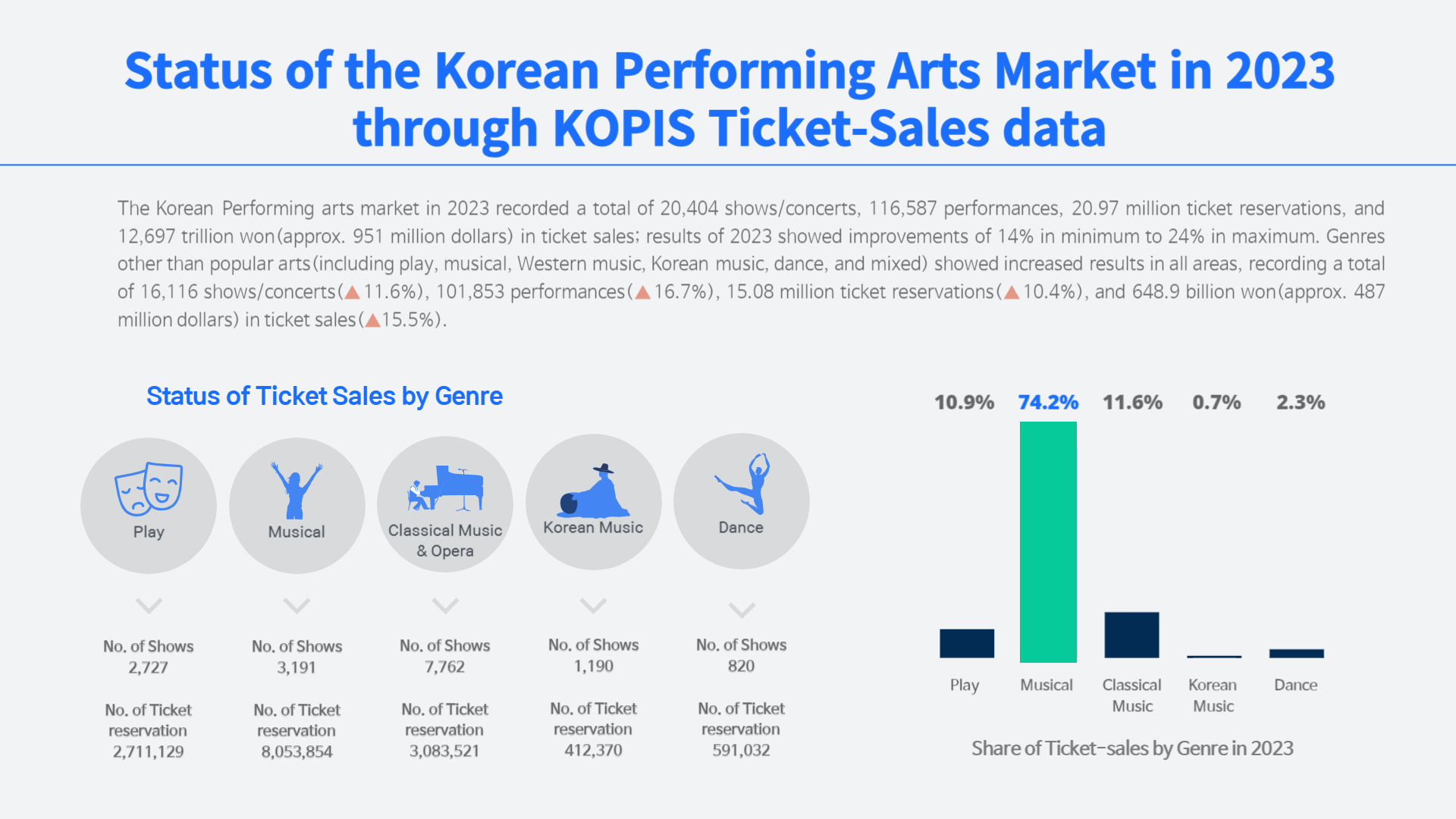
.jpg)
.jpg)
.jpg)
.jpg)











